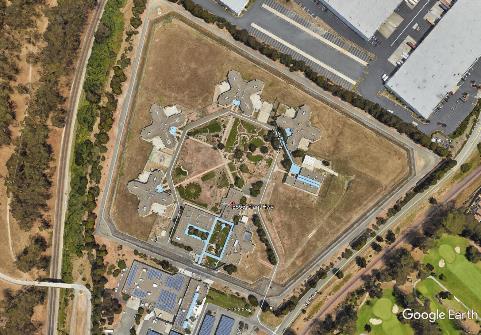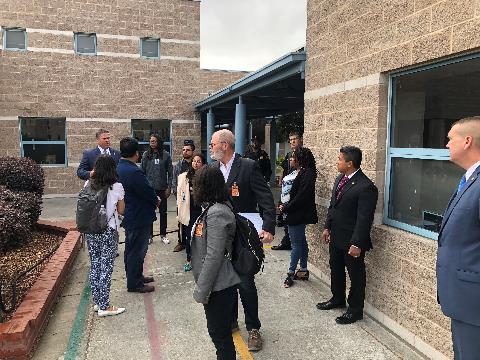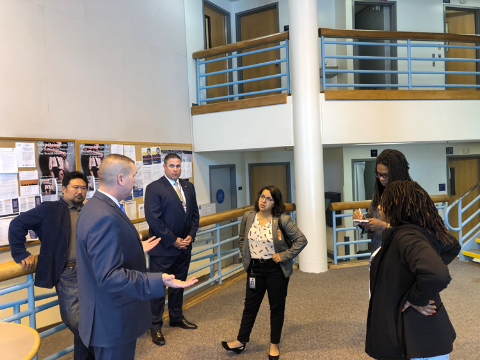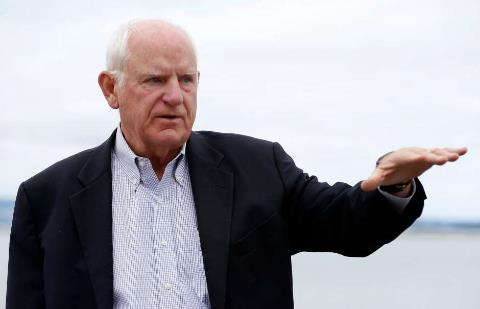|
| After months of requesting and being repeatedly refused, I was finally welcomed at the Contra Costa Sheriff’s West Contra Costa Detention Facility yesterday along with eight other people representing the City of Richmond and two journalists, Sara Hossaini from KQED and Otis Taylor, Jr. from the Chronicle. Two of the Richmond people were City Council members, Ada Recinos and Ben Choi.
Our tour guide was Sheriff’s Captain Tom Chalk. Irene Perdomo, one of several bi-lingual members of the Mayor’s Office staff, helped me with translations when needed.
From a physical perspective, I think we were all impressed with the facility. It actually looks more like a community college campus than what we think of as a jail. Inmates are walking all around, going to classes, work and other activities and appointments. The center of the complex is a nearly 4-acre landscaped “quadrangle” maintained by inmates.
It has a central kitchen, laundry, libraries, classrooms and a sign shop and frame shop where inmates can learn skills.
The residential portion of the facility consists of four “pods,” one of which is exclusively for male ICE detainees and one of which is for women, including ICE detainees. Each detainee has a sleeping room, but the toilet facilities are shared. Each pod has a dining area, lounge and other services. Inmates are generally free to come and go from their rooms, and they each have a room key so that they can lock their doors when they are out.
ICE detainees, men and women, all wear lime green outfits. Otherwise, men wear gold outfits, and women wear dark green outfits.
The various jobs inside are voluntary and pay no money, but those who take them get additional perks and privileges. All of the landscaping appeared to be done by ICE detainees, maybe an indication of their motivation to work hard.
We were not restricted from talking with ICE inmates, and we chatted up groups of both men and women. Some spoke English well, which is not surprising because they had been in the U.S. for many years. Other spoke Spanish either because they were not proficient in English or did not feel confident. There were several bi-lingual Spanish speakers in our group, which facilitated communication.
What I was most interested in was probing reports of abuse. The story we got from the men was quite different than that from the women.
The men we talked to, while critical of ICE for many reasons, had only good things to say about the West Contra Costa Detention Center. They said they were treated well and they appreciated the various educational programs and other opportunities. Some had been in ICE detention in other locations where they were treated poorly. They were greatly concerned about the closure of the West County facility as an ICE center, and they were worried they would end up somewhere less hospitable.
The women we talked to said that some of the deputies were racist and verbally abused them. I asked them about the reports of being locked in their rooms and not allowed to use the toilets. They said that was true, that sometimes they were locked in and were supposed to beat on their doors to be let out to use the bathroom. Sometimes, they said, they would not be allowed out.
I talked to Captain Chalk about those claims. He denied the claims, explaining that several times a day, there is a headcount, and inmates were confined to their rooms for a few minutes – 20 minutes max, and that of they had to use the bathroom, they could knock on their door and would be allowed out.
I don’t know which version is accurate, but there is clearly a divide between the men’s accounts and the women’s accounts, possible a result of a combination of gender and ethnic related clashes of both staff and inmates that engender split perceptions.
One thing I took away from the tour is that there are both upsides and downsides of closing the ICE facility, and there has been little discussion of the downsides. The fact that family visitation will be more difficult just came up the last few days, and the poorer quality of care at other facilities is the first I have heard of this issue.
Considering the generally good impressions that visitors had, I am baffled as to why the sheriff has been so reluctant to allow visitors.

Figure 1 - aerial view from Google Earth

Figure 2 - Our tour group just entering the quadrangle

Figure 3 - One of the living pods. This is the central area where dining, restrooms and other facilities are located. Sleeping rooms are on two levels.

Figure 4 - Our tour group walking around the perimeter of the quadrangle
https://www.sfchronicle.com/news/article/Richmond-s-Mayor-Butt-meets-ICE-detainees-13071095.php
Richmond’s Mayor Butt meets ICE detainees Otis R. Taylor Jr. July 12, 2018 Updated: July 12, 2018 6:01 p.m.

Richmond Mayor Tom Butt visited the West County Detention Facility and brought along a few guests, including Richmond City Council members Ben Choi and Ada Recinos and members of the Human Rights and Human Relations Commission.
Photo: Paul Chinn, The Chronicle
When he walked over to a group of inmates sitting on couches and leaning against columns in the common area outside of their jail cells, Tom Butt, the mayor of Richmond, didn’t waste time with small talk.
He asked the women — detainees of Immigration and Customs Enforcement — how they were being treated.
“They get mad anytime you ask them for something,” one woman said in Spanish, referring to the deputies patrolling the cellblock.
Her answer was translated by Irene Perdomo, one of the mayor’s aides.
We were inside the West County Detention Facility. The Contra Costa Sheriff’s Office operates the jail in Richmond, and the county has a contract with ICE to detain immigrants.
On Tuesday, Contra Costa County Sheriff David Livingston announced the county was severing its jail contract with ICE, following months of protests and pressure over the county’s connection with ICE.
Butt had been trying to get permission from the Sheriff’s Office to tour the jail since allegations of mistreatment surfaced nine months ago. He wanted to know if what Dianny Patricia Menendez told me last fall was true: Are female inmates at the facility sometimes locked up in their cells — which don’t have toilets, forcing some women to urinate or defecate on themselves or in plastic bags?
Butt finally got the approval to visit on Thursday and brought along a few guests, including Richmond City Council members Ben Choi and Ada Recinos, members of the Human Rights and Human Relations Commission, and me and one other news media reporter.
One inmate told Butt that deputies lock the doors and don’t open them when they’re supposed to. Another told him that deputies are racist. I’ve spoken to detainees who said deputies yell at them when they speak Spanish.
Claudia Gastelum, an inmate who was standing nearby as Butt spoke to other women, told me that inmates bang on the doors to let the deputies know they need to use the bathroom. And that causes problems.
“Sometimes if they hear you banging on the door, they just won’t come,” she said. “They’ll yell at you, and tell you, ‘I’m gonna take longer.’”
Gastelum, 39, says she has been detained at West County for three months. She was brought there after serving more than a year in the federal prison in Dublin for deliberately concealing knowledge of a felony. When she was released, she says ICE picked her up and brought her to West County, where she is fighting deportation proceedings.
Now, like other detainees, she’s worried about where she might be taken once the jail ends its ICE contract, within 120 days.
“We’re all tripping now, because we don’t know where we’re going to go next,” Gastelum said. “So we’re scared it’s going to be worse.”
She’s from Arizona, but I didn’t get to hear more of her story because I was ushered away so the tour could continue.
Tom Chalk, a sheriff’s captain, led the tour. We were joined by members of the Sheriff’s Office command staff, including Matthew Schuler, an assistant sheriff and commander of the Custody Services Bureau.
The West County Detention Facility is a minimum-security jail off Giant Highway in Richmond near the Point Pinole Regional Shoreline. It opened in 1991. Outside the jail, words written in chalk on the sidewalk during recent protests have yet to fade.
“We will remember who ICE is,” read one message.
On Thursday, there were 183 ICE detainees at the jail, an increase of 14 people since Tuesday’s announcement that the county was severing the ICE contract. Thirty-two of detainees were female.
“We’re going to work with ICE to try to get these cases adjudicated before they’re moved — if in fact they need to be moved,” Schuler said.
Before the tour began, Chalk gave an overview of what we’d see — the kitchen, the library, the classrooms with computers. Butt cut him off.
“The main reason I wanted to come out here was hopefully to have a chance to talk to some of the ICE detainees and just ask them how they’re being treated,” Butt said. “So I’m not really interested in the building.”
I noticed that our tour guides were hesitant to allow him to speak to detainees, but he was persistent.
And, surprisingly, the male ICE detainees were full of praise for the facility. Unsurprisingly, the women were the polar opposite.
“Why do you think it is the men seem to be just happy as clams here, except with ICE, and the women are like ... ” Butt said to Chalk.
“We don’t know,” Chalk responded.
“And the women have complaints,” Perdomo said.
I asked Chalk the same question I asked him the first time I toured the jail: Why is there such a disconnect between what the women are saying is happening and what command staff says is happening?
“We’ve been really, really paying attention to what’s going on, and none of this is substantiated,” he told me. “You’ve seen it more than once. Every one these doors is unlocked, and they can come out anytime to go to the bathroom.”
The doors are locked for count, which happens four times a day. Schuler said the inmates are only locked inside for 20 to 25 minutes.
We didn’t see many detainees in the cell modules. We were told most were in classes. We did see male inmates landscaping the grounds and working in the kitchen and laundry. They’re not paid, but they receive perks for working — like extra snacks on Fridays.
As we walked through the framing shop, Butt seemed impressed by some work done by inmates, many of them detainees. Chalk quipped that they were open for business.
Recinos retorted with a comment about minimum wage.
“As we know, a lot of immigrants that do come here generally do not work for fair wages,” Recinos told me after the tour.
San Francisco Chronicle columnist Otis R. Taylor Jr. appears Mondays and Thursdays. Email: otaylor@sfchronicle.com Twitter: @otisrtaylorjr
Richmond Mayor Visits Detention Facility Following Abuse Allegations
By Jackie Ward July 12, 2018 at 2:44 pm
https://sanfrancisco.cbslocal.com/2018/07/12/richmond-mayor-richmond-immigrant-detention-facility/
RICHMOND (KPIX 5) — Richmond Mayor Tom Butt toured the West Contra Costa Detention Center Thursday following reports of mistreatment of detainees, including immigrants detained by ICE.
Butt waited months to walk through the doors of the West County Detention Facility to see for himself how detainees were treated inside. The detention center has gotten attention because it has become a holding facility for undocumented immigrants.
“I haven’t been here since this facility opened maybe 25, 30 years ago,” said Butt.
Butt said he wanted to see the place where alleged mistreatment and abuse was happening in his city. He said that what he saw was different depending on whether he was speaking to a male or female inmate. The men said if they had to be detained, they preferred to be here. As for the women, “Some of the deputies are racist and they verbally abuse them,” Butt said the women told him. “And again, whether that’s accurate or not, I don’t know. I’m just telling you what they said.”
The mayor was joined by members of the city’s Human Rights and Human Relations Commission, who are concerned about what will now happen to the 169 detainees being held here by ICE after Contra Costa County sheriff David Livingston broke a contract with ICE earlier this week.
Chris Broglio of the Human Rights and Human Relations Commission said, ”Their attorneys are here, their families are here and they may very well be sent to Yuba, I understand, or other parts of the prison system.”
“The sheriff’s office does not do immigration enforcement. In fact, our policy prohibits it,” explained Sheriff Livingston.
The county says ending the contract was partly based on pressure from the public.
It’s now up to the federal government to decide what happens to the current ICE detainees being housed in the West County Detention Facility within the next 118 days. Sheriff’s deputies told Mayor Butt that they are working with ICE to try to clear as many of those cases before that deadline expires.
|

